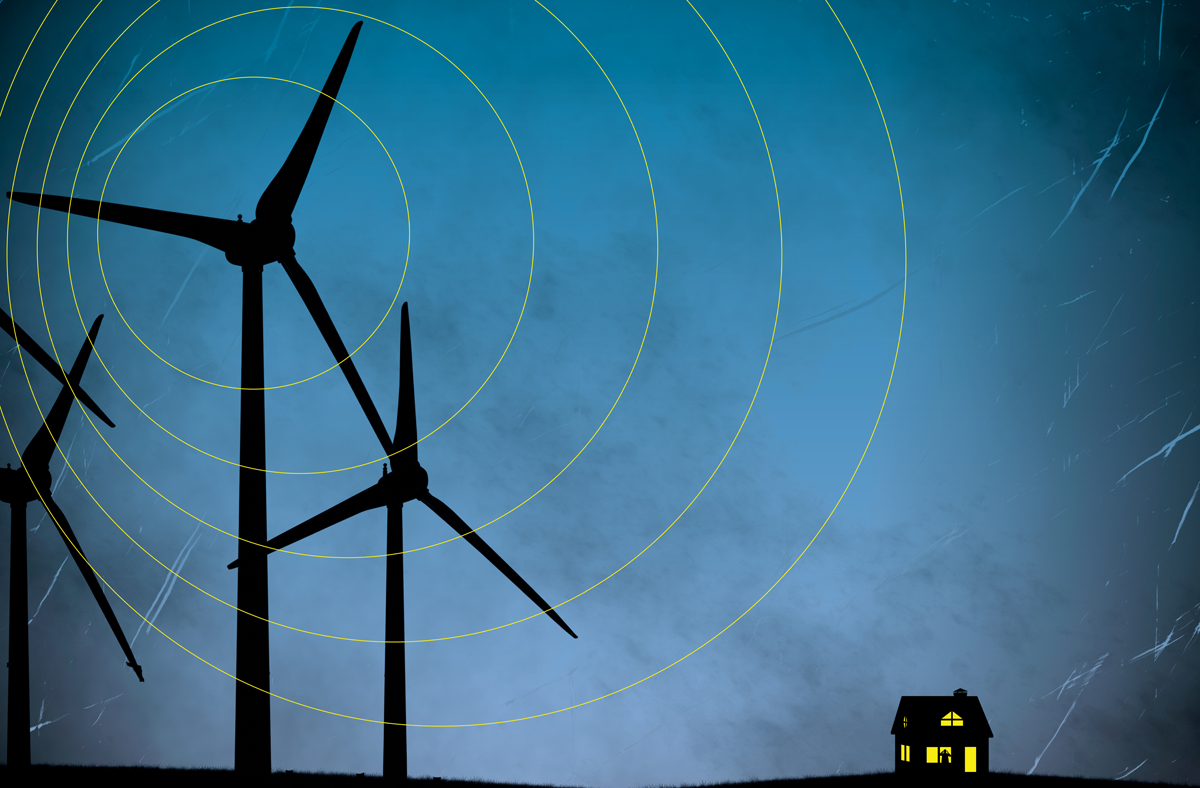Bad Vibes in Kingston, Mass.

It’s a gray, rainy August morning in the South Shore town of Kingston, and I’m standing in a gravel pit, looking up at a windmill that, at some 400 feet to the tip of its blades, is more than half the height of the Prudential Tower. I’d seen the giant turbine, and three other large ones, from several miles out as I approached from Route 3, but only now, standing right under it, can I appreciate the sheer size. As gusts of wind rustle the long grass at my feet, the turbine whirs steadily, the rotation of its 144-foot fiberglass blades, each weighing 6 tons, accompanied by a faint whoosh and whistle. A low electric hum emanates from the nacelle, a school-bus-size structure behind the blades that houses a generator capable of producing up to 2 megawatts of clean electricity. Operating at 35 percent capacity, as is typical for onshore windmills, that’s enough to power as many as 700 homes while producing 2,300 fewer tons of carbon dioxide each year than would conventional power sources.
The turbine, and the two others nearby, belong to No Fossil Fuel, a small company founded by a local businesswoman, who has converted some of the land below them into an organic farm. They cost about $2.5 million apiece and have together generated nearly $2.3 million in revenue since they went up at the end of 2011. Kingston, with a population of about 12,000, is also home to a 400-foot turbine that the town authorized a private developer to plant on a capped landfill in exchange for rent payments and a deal on electricity. Then there’s the comparatively miniature windmill—just 120 feet tall—that the MBTA operates next to Kingston’s commuter-rail station.
The turbines in Kingston are part of a fast-developing effort to build up wind power in Massachusetts. Last year there were 43 onshore wind projects in the state supplying enough energy for about 32,000 homes, and more than half of that capacity had come online since 2012. Another five times that capacity was in the planning or permitting stages last year. Governor Deval Patrick has set a goal of wind supplying Massachusetts with 10 percent of its electricity—enough to power 800,000 homes—by 2020. That would mean as many as 1,000 turbines on land and offshore. And that has a lot of people concerned, because even though polling shows that most Massachusetts residents support the turbine effort, windmills, as I’ve begun to learn during my time in Kingston, produce a lot more than just clean energy.
To the east of the gravel pit where I’m standing is Route 3, known along this stretch as the Pilgrims Highway, and on the far side of the busy roadway is a cul-de-sac of modest gambrel and split-level houses built around 1980. In one of these lives the Reilly family—Doreen, her husband, Sean, and their three teenage children. The turbine on the landfill is 960 feet from their back door.
“It makes you sick—you have to leave your home,” says Doreen as we sit around the Reillys’ kitchen table after work one evening. A 49-year-old hospital registrar who usually works a swing shift, she tears up from time to time as she talks about the turbine.
Sean, a fit 49-year-old with a blond buzz cut, describes how for several weeks each year the setting sun behind the turbine casts the house in a moving shadow. “The flicker illuminates the whole room,” he says. “It takes over the whole house.”
“And the noise from a turbine is something else entirely,” Doreen says.
“It’s just a pulsating noise that goes to different pitches,” Sean explains. “It gets in your house—there’s a pressure to it. There’ve been nights when it’s woken me up every hour, on the hour.”
Sean would like to move away, and the couple has made a halfhearted effort to sell their home of 20 years. But Doreen and a handful of other Kingston residents have also taken up a battle to get the town’s windmills turned off. They’ve amassed reams of documents, attended meetings of various town boards, and spoken against the turbines to neighbors and local media. “I have put in maybe 200 hours at least on this turbine,” Doreen says. “I’ve read more about turbines than I ever wanted to know.”
For help, Doreen and her neighbors also did what scores of homeowners across Massachusetts have done when faced with a windmill in their backyard: They looked to the grassroots organization that has emerged as the face of the state’s anti-turbine movement, Wind Wise Massachusetts. Relying on volunteers and individual donations, the group has worked to defeat wind projects from Nantucket to Lenox. (Its list of “dead” projects now numbers 48, most of which were killed by opposition from nearby homeowners.) Wind Wise and its allies believe wind turbines are noisy and ugly, and that their ability to reduce greenhouse gases has been vastly overstated. The group also believes windmills are responsible for wind turbine syndrome, a controversial diagnosis involving dizziness, nausea, headaches, ear pain, and an array of other frightening symptoms in people who live too close to large turbines.
In addition to the turbines Wind Wise has managed to scuttle, it has been able, so far at least, to block a proposed state law that would relax regulations and make it easier to build new windmills. “We have no money, really,” says Virginia Irvine, a Brimfield resident and the president of Wind Wise. “We try to bring information to people, and it’s really difficult when you are a grassroots organization.” The cause is helped by the fact that Wind Wise now has volunteers in 200 towns and about 20 affiliated local groups. It also maintains an active Web presence, mobilizes speakers to testify on Beacon Hill, and employs an energetic PR man.


